

|
The Magic of Scheherazade was released in Japan in 1987 and in America in 1989, but I didn't actually play it until sometime around 1991. By then, it had been around long enough that I was able to find it quite easily in a bargain bin for $15. Despite the fact that I knew nothing about it (as Nintendo Power gave it very little coverage), it was hard to pass up for that price, since I had very little money back then. At the time, I had thought it was easily the best $15 I'd ever spent. One of the reasons The Magic of Scheherazade is such an important gaming memory for me is that it was the very first game I played that had menu-driven battles. Indeed, when I first found myself in the midst of one, I had little idea what the heck was going on. I was choosing commands left and right, not really understanding what any of them did, and the game would carry them out for me, and man, I just had no clue what I was seeing. It didn't take long for me to catch on and then the rest, as they say, was history. This is the game that got me hooked on RPGs. I guess I was just lucky in that the first one I experienced, despite not being a very popular RPG, was one that lived up to the genre's overall reputation for having great soundtracks, absorbing atmosphere, and fun characters. The story isn't exactly the most deeply-written I've seen, but it has a good amount of humor, some really weird memorable parts, and a mind-blowing surprise plot twist. It also has a unique Arabian setting, which very few RPGs have done, and an interesting mix of both action and command battles. It was this game, even moreso than The Legend of Zelda which I'd played earlier, that opened my eyes to the genre, and inspired me to hunt down other great NES favorites like Final Fantasy, the Dragon Warrior games, Little Ninja Brothers, Crystalis, Willow, Destiny of an Emperor, Faria, Might and Magic, the Ultima games, and many more. It is for this reason that I have decided to give this game the FlyingOmelette.com "Shrine Treatment". I hope that it will bring more attention to one of the most overlooked games of our time.
 The following passwords will warp you to the beginning of a chapter with the maximum experience level and all the items, spells, and allies for that chapter and all previous chapters already collected. Essentially, you are ready to go right to the boss:
The following passwords will warp you to the beginning of a chapter at the minimum experience level and without any items, spells, or allies for that chapter collected yet, but everything for the previous chapters will be collected. Essentially, you are just starting the chapter. NOTE: You will need to enter these a few times before the game will accept them:
END = Enter this password to view the ending sequence of the game. SOUND = Enter this password for a Sound Test. The "D" will be separated from the rest of the word, but it still works. NOTE: I actually discovered this code on my own years ago. It was right around the time I first learned about certain NES games having hidden sound tests (like Ninja Gaiden and Godzilla). Nintendo Power mentioned that if you enter "END" as a password, you could see the ending to this game. So I wondered if entering "SOUND" would give you a sound test. I was totally expecting it wouldn't work, especially since the "D" wasn't connected, so you can imagine my ecstatic surprise when those double zeroes appeared. Actually, I thought I made the game freeze as it took me a few moments to figure out that you need to press "Start" to get the music to play.
 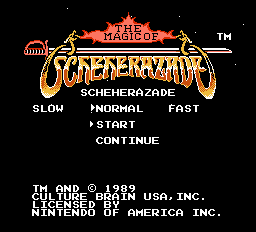 The game's title character, Scheherazade, is taken from The Book of One Thousand and One Nights, aka 1001 Arabian Nights. It is a collection of stories told by the character Queen Scheherazade to her husband, who is going to execute her. However, she ends each story on a cliffhanger, which causes the king to suspend her execution for another day so that he can hear the end of the story. Some of the most famous of these tales, which are often told on their own outside of the collection, are Aladdin, Ali Baba and the Forty Thieves, and The Seven Voyages of Sinbad.  The first world is called "Water World Mooroon". I believe the word "Mooroon" to be a combination of "Mu", the Lost Continent, and "maroon", as in being stranded on an island after a sea or ocean voyage. In the past of Mooroon there existed a town called Horen and an Aqua Palace that both sank to the bottom of the ocean, just like the fabled lost continent of Mu. (It should be noted that "Mu" was also translated as "Moo" in Culture Brain's Super Ninja Boy. In that game, Moo is an underwater city.) Forum moderator SethraShnoo also suggested that "Mooroon" could have been named after the Moors, who were medieval Muslims that came over from western Africa to the Iberian Peninsula, which includes present-day Spain and Portugal. Considering the game's setting, it makes sense. Hmmm...I personally feel either theory is possible, and in fact, it might be meant as a reference to both things. A double-meaning, so to speak.  Coronya's name appears to be a combination of "Corona" and "Nya". I believe Corona is a reference to the outer atmosphere of the sun, not the Mexican beer. "Nya" is essentially the Japanese equivalent of "meow". Since Coronya is a cat, this makes perfect sense. She was probably also named this because of the Alalart Solar Eclipse that occurs every so often in the game. During an eclipse, the sun's corona is visible, as seen in the background image of this site. (Thanks to Magical Yard Gnome for help with this one.) Another example of the use of "Nya" in a cat character's name is Namco's "Nyamco", the villain of the Mappy series.  Gilga, the boss of Chapter 1, might be named after Gilgamesh from The Epic of Gilgamesh, which is believed to be the oldest written story on Earth. However, Gilgamesh was the hero of the story, not the monster. (The monster was named Humbaba.) Although this wouldn't be the last time an enemy in a game was named after Gilgamesh (See also Final Fantasy V).  The second world is called "Desert World Alalart". It contains towns called "Malart" and "Alart". The Alalart Solar Eclipse that occurs every so often in the game is also named after it. Now, I'm not 100% sure about this one, but I think it might be a reference to "Allah", the Islamic term for "God". Since the Alalart Solar Eclipse is supposed to create miracles, it would make sense.  This one I'm not real sure of, either, but I think it's possible that Gun Meca, the robot you meet in Chapter 2, was inspired by C-3PO from Star Wars. He looks vaguely like him and his main task in the story is to translate the ancient Peke Peke language. C-3PO was programmed to be "fluent in over six million forms of communication." The mortarboard that Gun Meca wears on his head implies that he is an intellectual, which can easily bring to mind C-3PO's proper way of speaking. If not, then one thing I can definitely confirm is true about him is that the symbol on his chest is the Japanese symbol for Yen, Japan's national form of currency.  Unlike the last two, I'm pretty much sure of this one. The Dark Demon Curly is most likely a mistranslation of Kali, the Hindu goddess, largely thought of in some cultures as being a deity of destruction and evil. Curly's multiple arms are a distinct clue to her being based on Kali. Kary, the multiple-armed Fire Fiend boss of the Gurgu Volcano in Final Fantasy, is also most likely based on and named after Kali. Kali was also mistranslated as "Curly" in Castlevania: Aria of Sorrow, and as "Cali" in the Gameboy version of Azure Dreams.  Pukin is a living doll that joins your party in Chapter 3. He is brought to life by a dollmaker named Supapa. Seems quite likely these characters were inspired by Pinnochio and Gepetto from the classic tale of Pinnochio. Pukin's rather funny name is probably a shortened version of "Pumpkin", since he has a Jack O'Lantern for a head. (I doubt he was named this because of a tendency to vomit.)  Another one that's conjecture on my part, but I have to wonder if the Wizard Mardul was inspired by the Disney movie Fantasia. His helpers are dancing brooms, like the ones seen in the "Sorcerer's Apprentice" segment. And the fact that he turns into a dancing flower is reminiscent of the "Dance of the Reed Flutes" segment.  Salamander is named for the mythological version of the amphibious creature. The salamander lived in fire and it was believed that clothing made from its skin would be fire-resistant. Over the years "Salamander" has come to define almost any monster in popular culture that resides in or is otherwise made of flames.  Possible reference submitted by Crawl and 1000: King Feisal might be named after Prince Feisal, who had led the Arab revolt in the early 1900's and eventually became King of Iraq from 1921 to 1933. He was portrayed by actor Alec Guinness in the movie Lawrence of Arabia.   Easy reference: The Medusa and Gorgon enemies are based on the Gorgon sisters of Greek Mythology. They have snakes for hair and a look that can turn a man to stone. The Medusa and Gorgons in the game have a glare attack that can turn a party member into a rock which disables both your magic and physical attacks until it wears off.  The design of Goragora seems to have been based on Janus, the Roman god with two (or sometimes four) faces looking in opposite directions. Janus is the god of gates, doors, beginnings, and endings, which all makes sense for Goragora as well. Goragora is found at the gate (or door) between the Human World and the Dark World, which the Pillars have sealed off. And being the ultimate demon of pure evil, he could bring about the end of the human world and the beginning of a new one ruled by demons.  The party formations that you learn in this game to combat certain enemy formations are all named after Zodiac stars and constellations. Cygnus is the bird constellation, also known as the Northern Cross. Sirius is the brightest star in the nighttime sky. Libra is the constellation also known as the balance or scales. Dragon is probably named for the dragon constellation, Draco. Aries is the ram constellation. Baten Kaitos and Deneb Kaitos are two stars that make up Cetus, the whale constellation.
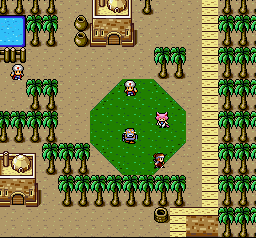 Culture Brain's Super Ninja Boy for the Super NES has several references to The Magic of Scheherazade, most of which occur in one specific town, Celestern. Celestern is named after the world that the last two chapters of The Magic of Scheherazade take place in, and its theme music is the town music from TMoS, except that it is much slower (Download MP3). Although they are not named, there is no denying that the pink cat and the robot you find in this town are none other than Coronya and Gun Meca. I am not sure if there is subtle implication that the guy standing with them is the Hero from TMoS. He is certainly dressed the same, but all the generic people in the town look like that. It is only his proximity to his former party members that would give him away. 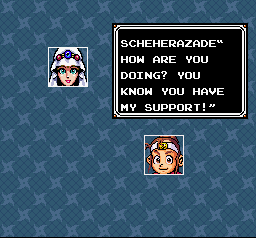 You will also meet Scheherazade herself in Celestern. She is the town's leader. You can't have a more blatant cameo than that.  The Magician Airosche is also a TMoS reference. Although "Airosche" is not a character in TMoS, it is the name of the Blue Star that is the kingdom's Guardian Deity. During the Alalart Solar Eclipse, the light of the Blue Star of Airosche is supposed to be much brighter since the sun's light is blocked out, which causes all kinds of miracles to occur. Note that Airoche's crown in Super Ninja Boy has a very large blue gem.  There is also a reference to The Magic of Scheherazade in Culture Brain's other NES RPG, Little Ninja Brothers (the predecessor of Ninja Boy 2 and Super Ninja Boy). After you beat the Evil Queen in the Waterlily Palace, talk to the fairies that appear in there. One of them will mention that the background music is Rimsky-Korsakov's "Scheherazade". Although this music really is part of Rimsky-Korsakov's "Scheherazade", there is no doubt in my mind that its use in this game is meant as a nod to TMoS. 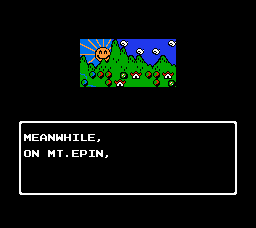 Another blatant reference in Little Ninja Brothers to The Magic of Scheherazade is right in the opening story sequence. The name of the mountain where Jack and Ryu live, Mt. Epin, is named after the character Epin in TMoS. Epin joins your party in Chapter 2.
 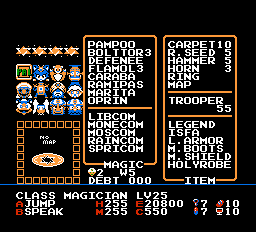
Keep Coronya in Chapter 5! If you use the 5W password to skip directly to Chapter 5, you'll begin with all the items in the game, including the Legend Sword, Isfa Rod, and Light Armor, AND you'll still have Coronya! You can still use her in battles, make the Cygnus formation, and she'll tell you when to use OPRIN. This will not have any effect on anything else in the game, though. 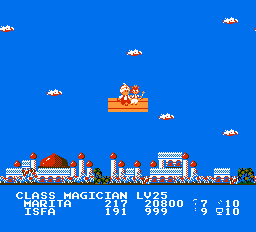 
Phantom Coronya Even after you lose Coronya, if you use a Magic Carpet or go to the Time Door, she shows up again anyway. 
Antlion Wraparound Glitch When fighting the Antlions that bounce around in the desert, push one up against the top of the screen with your sword or rod. Sometimes, it will get pushed up off the screen and reappear in the menu area at the bottom. There are other enemies that can sometimes be pushed into the menu, but it's easiest to do it with the Antlions. 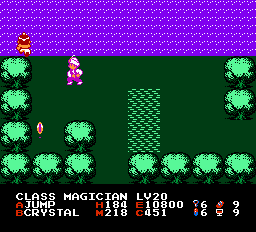
Thief in the Water Sometimes, the thieves that appear on the overworld start out hiding in the trees. They'll bounce around in the trees until they land on solid ground. However, occasionally, on screens that have water, they'll leap from the trees and land in the water. If that happens, the thief becomes frozen in place, never to move again.  
Ring Weirdness When you get into a fight with one of the palace wizards, Changarl, Mardul, Warhammer, or Barzil, let him change your shape. Then quickly use the ring before you get killed by the wizard's helpers. Kebabu will pull you out of the fight as usual, but during the cinema scene, you'll look like whatever it was the wizard changed your form to. Kebabu's color palette will also change to match the object you turned into.  
Beckal's Fate When you time travel back to the past of Chapter 1, before the water demon Gilga sinks the town of Horen, you'll meet a fellow named Beckal who doesn't want to move no matter what. With Faruk's power, you'll be able to breathe underwater and visit the sunken town of Horen in the world's present time. And yes, Beckal is still there and still gives the same message. How? I have no idea.  
Crazy Hammer Head This one just boggles my mind. For some reason, when you equip a Hammer, it appears on top of the hero's head!! It looks ridiculous and it reminds me of that Saturday Night Live sketch where Adam Sandler said he had a crazy spoon growing out of his head. I tried hard to come up with a reasonable explanation for this, but couldn't. However, forum moderator and fellow MOS fan SethraShnoo came up with this plausible theory: "It seems the logical explanation is that Culture Brain couldn't animate him carrying it in his hand for some reason (possibly budget, laziness, time, who knows?) I actually have a theory that the hammer's original purpose was to be used in tandem with the kibra horn, because you're told to "pound it into the statue", but instead, he shoots the horn from his rod. So maybe sticking it on his head was a last-minute fix when they changed the hammer's purpose." It's as good a theory as any I could come up with. 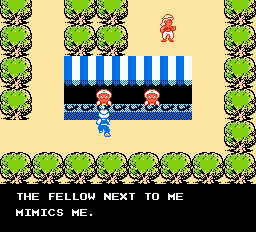 
Bazaar Humor These little guys who hang out in the street bazaars are a great source of self-aware humor. Even if there are more than one on a screen, they all always say the same exact thing. The writers decided to have a little fun with that and actually make a joke out of it. In another town in Chapter 2, a person on every screen tells you to use OPRIN. So when you get to this bazaar fellow on the last screen, he's somehow aware of this and says, "Now you know what I will say. Yes, use the magic of OPRIN here, too." 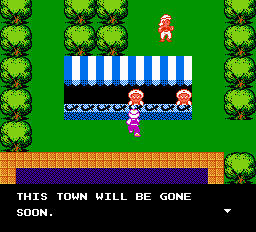 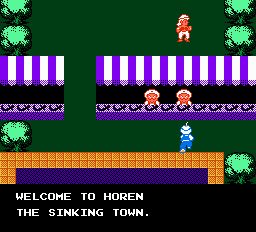 These guys also tend to be the most pessimistic characters in the game. In every chapter that has them, they'll complain that their town is going to be destroyed by whatever demon rules the nearby palace. Sometimes, they do it with a touch of sarcasm, like that "sinking town" line.  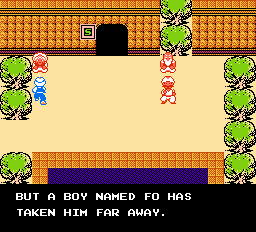
Time Paradox The Magic of Scheherazade is usually quite consistent about its time paradoxes. Usually, the effects of what you do in the past are not seen until AFTER you actually go back and do them. Occasionally, though, you might see some of the effects ahead of time. Case in point when you talk to Zainab about Supica. She tells you that someone with your name came and took him away 500 years ago. At this point, you haven't actually done this yet, although you will. Contributed by Timothy Rankin If you use Moscom before you get Rainy and Gubibi, either Rainy or both Gubibi and Rainy (depending on who you are missing) join you then. Once you change your class, the imam says "I will give you an attendant. Take friends with you", and your new allies say "I'm Gubibi/Rainy. I'm glad to meet you." This makes it possible to beat the game without ever being a Fighter. However, your new allies will have 0 MP and 1 HP, so before you fight Salamander, you will need to give Rainy some MP, either by staying at an inn or using Epin's whistle (put Epin in the last slot). Also, if you get Gubibi this way, you will never be able to get the Holy Robe. FO's Note: Although you wouldn't need the Holy Robe since its only purpose is to get Rainy. Contributed by SethraShnoo & Timothy Rankin It is possible to beat the game without ever getting Supica and Gun Meca. While all the other characters have checks in place to make sure you don't beat a chapter without them, the programmers failed to put any for these two characters. If you know the correct way through the desert maze in Chapter 2, you can reach Sudari, and consequently, the Dark Palace without ever getting Supica to guide you through it. Normally, you would need Gun Meca to be able to recruit Supica, but you can skip both with this method. The side effect of this is that during the menu-driven battles, you will not be able to select any characters below where Supica and Gun Meca appear in the line-up because the cursor will not move through the blank spots. The only way to get characters below where these two should be into your party is by selecting the proper "Formation" from the "Formation" selection screen. Supica and Gun Meca will still show up in the cutscenes. Apparentely, the cutscenes aren't dependant on who is actually with you, they're all programmed just one way. All of the other characters have a check in place to make sure you can't skip them: Contributed by Timothy Rankin For some specific level numbers, once you level up and reach that level, you automatically get a key if you don't have any keys. If you already have a key and level up, you will not get another key. So far I know the following: 5, 6, 16, 18, 19, and 22 are "key levels" (meaning you get a key when you reachthis level, if you have no keys). 1-4, 17, 20, 21, and 23 are not "key levels". For the missing level numbers, I don't know of any way to use keys in chapters 2 and 3, so I don't know of any way not to have any keys when you level up in them (after level 6) short of cracking the password system. As for 24 and 25, I just got tired of walking around killing little bony guys over and over for 12 points at a time. I tried some levels several times, with different amounts of bread/mashroob/amulets, different equipment, different allies, etc., and whether or not you get a key was not affected. Whether you leveled up during the chapter or at the end after beating the demon also did not change things. The game was consistent about which levels give you a key, so it is not random, and it seems too specific to be a glitch, so I imagine this was intentional. This means you can beat the game without ever buying any keys (or using Monecom, obviously). Use the key from level 5 to get Moscom (but be sure to do so before reaching level 19), then use the key from level 18/19 to get the Legend (before you reach level 22), then use the key from level 22 to reach Sabaron. I imagine few players know about this since most players will use Monecom before they ever reach any of these levels, and those who don't use Monecom will still likely buy keys in Horen before reaching level 5. Contributed by Timothy Rankin Your class affects the discounts shopkeepers give you, and the shopkeepers tend to be stingier with Magicians. For instance, in the shop in Meshudo, if you are a Fighter or a Saint, the shopkeeper will give you half off on everything if you ask for a discount. If you are a Magician, the shopkeeper will boot you out if you ask for a discount on bread, mashroob, or carpet, and he will only reduce the price of R. Seed from 100 to 90 rupias. Also, in the shop in Pao in Chapter 5, the shopkeeper will reduce the price of a key from 40 to 20 for a Fighter/Saint, but only to 30 for a Magician. (I didn't check the other items.) Contributed by Timothy Rankin In the past in Chapter 5, there are no turn-based encounters in the half of the palace before you walk through the jar. In the part of the palace after walking through the jar, turn-based encounters are extremely common, probably more common than anywhere else in the game. Knowing this can be helpful if you want to level up here without getting into random encounters. |



